Mastering Hit or Stay Decisions in Blackjack

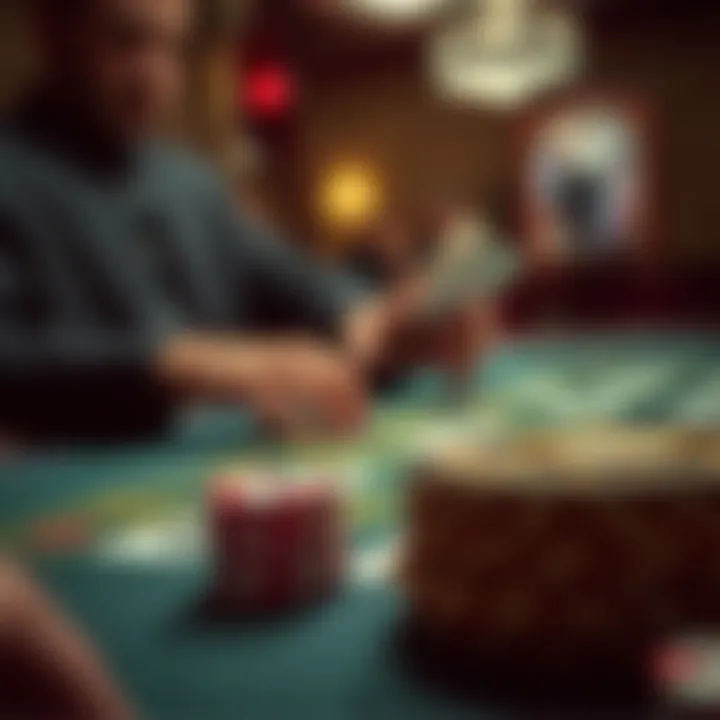
Intro
Understanding whether to hit or stay in blackjack can feel like walking a tightrope. The stakes are high, and even a seemingly small decision might turn the tide. The choices a player makes are rooted in a complex web of strategy, probability, and psychology. This article doesn’t just scratch the surface; it dives headfirst into the nuances of these decisions, providing insights that could elevate one’s gameplay.
In this exploration, we will highlight not only the foundational rules that govern blackjack but also the detailed statistical probabilities at play. The psychological elements of the game also come into focus; understanding how emotions and mindset can sway decision-making is crucial for anyone at the table. By closely examining essential strategies, potential risks, and practical scenarios, we aim to craft a robust guide for both novice and seasoned players. This isn’t just about luck; it’s about informed decision-making and smart betting practices.
Intro to Blackjack Strategy
In the game of blackjack, much like a chess match, every move carries weight and significance. The foundation of successful play rests upon a well-developed strategy that dictates when to hit and when to stay. Diving into the intricacies of blackjack strategy not only enhances your enjoyment of the game but also sharpens your competitive edge at the table. Understanding these foundational strategies equips players with the necessary toolkit to navigate the complexities of decision-making in a high-pressure environment.
Understanding the Basics of Blackjack
Before delving deeper into the nuances of hitting or staying, it’s essential to grasp the basic mechanics of blackjack. At its core, this card game involves players trying to accumulate a hand value closer to 21 than the dealer without exceeding that number. The values of the cards are straightforward: face cards are worth ten, aces can be one or eleven, and numbered cards hold their face value. This simplicity belies the challenging strategy behind forming the best hand possible.
Acquainting oneself with how hands are formed, and how they relate to one another, sets the stage for strategic decisions. Each player receives two cards, while the dealer reveals one, providing crucial information for calculating risks and making informed choices. Lack of awareness in this segment could lead a player to inadvertently toss away winning opportunities with hasty decisions.
The Importance of Strategic Decisions
When it comes to blackjack, the choices players make can be game-changers. The decision to hit or stay is critical and heavily influenced by several factors including card totals and the dealer's face-up card. A strategic approach demands that players evaluate their hand's value against the likelihood of busting if they decide to hit.
Moreover, second-guessing your own strategy often leads to confusion and poor gameplay. Thus, having a solid understanding of the strategic choices not only improves potential outcomes but also enhances overall gameplay experience. Notably, even seasoned gamblers can falter if they allow emotions to hijack their logic during critical moments in the game.
"In blackjack, it’s not just about the cards you hold, but how well you play them against the dealer’s hand."
The Hit or Stay Dilemma
In the game of blackjack, the moment you must decide whether to 'hit' or 'stay' stands as a critical juncture. Understanding this choice can profoundly influence your odds at the table. A player’s decision isn't merely a product of instinct; it requires assessing the hands in play, number probabilities, and how those interact with the dealer's showing card.
The dilemma can stir up anxiety, especially for novice players or those carried away by emotion. It’s essential to grasp the importance of these two actions and the rewarding strategies behind them. When one opts to hit, they seek to improve a hand that may be lacking—the thrill of chasing a better total is palpable. Conversely, deciding to stay indicates a measure of confidence in one's current hand.
Benefits of mastering the hit or stay predicament include:
- Enhanced Winning Potential: Smartly calculated decisions can lead to more wins than losses.
- Improved Fund Management: Knowing when to take risks can effectively protect your bankroll.
- Gaining Strategic Insight: Recognizing patterns may give you an upper hand over time.
In the subsequent sections, we shall peel back the layers of what it means to hit or stay, weighing the tactical advantages versus the risks involved. Each choice carries its weight, and contextual understanding is paramount.
Defining 'Hit' and 'Stay'
To begin, it's crucial to define the terms 'hit' and 'stay.' When you choose to hit, you are requesting an additional card from the dealer to improve your hand's total value. This option is typically exercised when your total is low, signaling an opportunity for a stronger combination. On the other hand, to stay means you are choosing to keep your current hand without taking more cards. This choice is often made when your total falls within a competitive range, and the risk of busting with another card outweighs the potential benefit.
The decision to hit or stay is heavily influenced by your hand's current value, the dealer's exposed card, and the general flow of the game. A clear understanding of these will guide you through this pivotal moment.
The Role of Dealer's Up Card
The dealer's up card factors heavily into a player's hit or stay decision. It serves as a window into the potential strength of the dealer’s hidden hand. For example, if the dealer is showing a weak card—say, a 4 or 5—players might lean toward staying on lower totals, banking on the dealer's chance of busting. Alternatively, if the dealer shows a 10 or an Ace, many players might choose to hit, aiming to reinforce their hands against a likely stronger dealer total.
Key points regarding the dealer’s up card include:
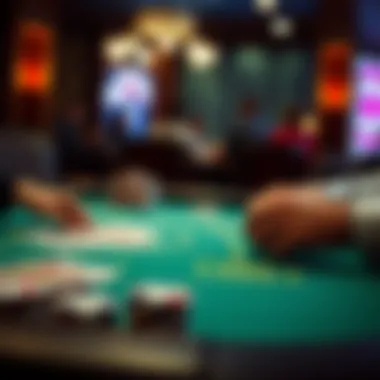
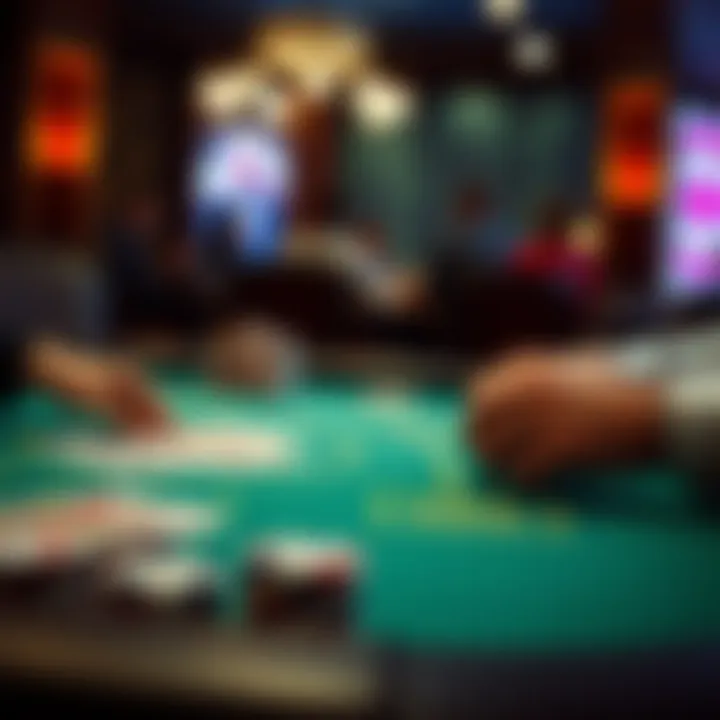
- Assessing Weakness: A weak card indicates potential for the dealer to falter.
- Calculating Risks: Holding a strong hand against a dealer's ten can push players to hit for safety.
- Strategic Variability: The choice to hit or stay may vary considerably based on dealer trends observed throughout the game.
In summary, navigating the hit or stay dilemma demands understanding both your own hand and the dealer’s potential. The more adept you become at interpreting these signals, the more strategic your decisions will be, ultimately enhancing your performance and enjoyment at the table.
"Understanding nuances in the hit or stay decision is as vital as knowing hand values in blackjack. Your choice can flip the odds in your favor with precision strategy."
For further insight into blackjack strategies, consider checking resources like Wikipedia, Britannica, or engage in discussions on Reddit.
By keeping a pulse on the dynamics of the hit or stay dilemma, players can enhance their understanding and sharpen their edge in the exhilarating world of blackjack.
Fundamentals of Basic Strategy
Understanding the fundamentals of basic strategy in blackjack is like having a compass in the fog—it guides players through the murky waters of decision-making. This article highlights why such strategies are crucial for both novice and seasoned players.
Basic strategy centers on minimizing the house edge, allowing players to make the statistically most favorable decision based on their hand and the dealer's up card. It’s key for improving one's chances of success at the table. In essence, it provides a template, a sort of roadmap, for hitting and staying decisions, thereby reducing emotional and impulsive play, which can lead to costly mistakes.
The benefits of adhering to basic strategy are manifold. Not only does it lend structure to gameplay, but it also assists players in betting wisely and conservatively. With every decision backed by numbers, players can step out of the shadows of guesswork and into a realm where intellect governs their choice. Moreover, practicing this strategy can lead to consistent outcomes, helping calm the nerves of those new to the game.
Foreword to Basic Strategy Charts
Basic strategy charts can be regarded as the go-to manuals for understanding when to hit or stay in various scenarios. These charts, which outline specific plays aligned with total hand values and dealer's up cards, help streamline decision-making under pressure. The statistical probabilities incorporated within these charts provide a balanced perspective on how to approach each hand. For instance, if holding a ten and the dealer shows a five, the chart typically suggests standing. Without these charts, players might second-guess their instincts and veer off the path to success.
When to Hit Based on Total Value
Determining whether to hit based on total hand value is a pivotal consideration in blackjack. A player needs to assess their hand’s strength against the dealer’s potential hand. For example, if your hand totals less than 12, hitting is generally advisable since the risk of busting is low. Conversely, if your total is 17 or higher, staying is favored as the chances of busting increase significantly.
In situations where the hand value hovers around the middle ground—say between 12 and 16�—decisions become trickier. Here, the player must weigh the dealer's up card. If the dealer shows a low card (2 through 6), it might be wise to stand since the dealer is likely to bust. However, if the dealer has a 7 or higher, hitting might be more prudent, aiming to surpass the dealer's potential total.
Scenarios for Staying
Recognizing when to stay is no less important than knowing when to hit. Various scenarios lend themselves to this decision. Generally, hands totaling 17 or higher are prime candidates for staying. At this point, the player’s chances of winning often outweigh the risk involved in taking another card.
Additionally, situations must be evaluated dynamically. For example, if a player stands with a twelve against a dealer showing a 5, the strategy shifts again. Staying is sensible here due to the dealer’s vulnerable position and likelihood of busting.
Ultimately, mastering these decisions—when to hit and when to stay—can elevate one's Blackjack play from random chance to strategic finesse. With this comprehensive knowledge in hand, players can navigate the complexities of the game more effectively, ensuring that every choice they make is informed and rooted in sound strategy.
Risk Assessment in Decision Making
Assessing risk is a critical aspect of playing blackjack. Without understanding the intricate dance between the player's hand and the dealer's up card, it's easy to make choices that could leave one empty-handed. In blackjack, every decision might lead you to victory or defeat, emphasizing the necessity of a thorough risk assessment approach. This section dissects how to evaluate your current situation, integrating statistics, probabilities, and player psychology into your decision-making process.
Assessing Your Hand vs. Dealer's Hand
At the heart of blackjack strategy lies the evaluation of one’s hand against the dealer’s up card. A player needs to gauge not only the total of their own cards but also anticipate how the dealer's hand might develop. For instance, if you’re sitting on a total of 14 and the dealer shows a 7, it’s a tricky situation. The dealer is likely to have a decent hand that could lead them to 17 or more as they are forced to hit until reaching at least that total. Thus, knowing well when to hit or stay can help mitigate the risks significantly.
- Hard versus Soft Hands: One key factor in decision-making is whether your hand is a hard hand (no aces counted as 11) or a soft hand (with an ace counted as 11). A soft total allows for more flexibility in hitting since an ace provides that cushion against busting.
- Dealer's Bust Potential: Think about the dealer's risk of busting. If the dealer's up card is a 4, 5, or 6, they’re in a challenging position. Understanding this helps you make decisions with higher probabilities of success.
- Statistical Outcomes: Reviewing statistics on what outcomes arise from various total hands against specific dealer cards can refine intuition.
"The bets you make and the choices you select will dictate your success more than any luck you hope to achieve."
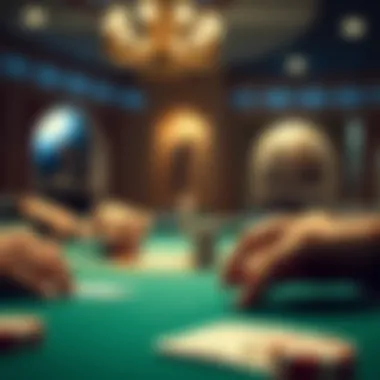

Probability of Busting
Understanding the probability of busting is paramount when contemplating whether to hit or stay. Each card drawn can change the odds not just for you but also for the dealer. For instance, if you have 16, hitting could lead you directly into the perilous waters of busting more often than not, especially if the deck returns a ten-value card.
- Calculating Your Risk: If you were to hit on 16, statistically, there’s a solid chance (~61%) that you would draw a ten or face card. That’s a pretty risky move, right? Consider whether the potential for reaching 17 or more outweighs that chance to bust.
- Adjusting for Deck Composition: The composition of cards left in the deck also matters. Card counting can significantly shift the player's understanding of bust probabilities. Knowing what's left can provide clarity on whether drawing a card is a sensible option.
- Dealer's Hitting Criteria: Recall that the dealer must hit until they reach at least 17. This inherently creates its own probabilities, judging how many third cards could improve the dealer's hand without busting.
In a game that amalgamates chance and strategy, honing the skill of risk assessment is indispensable. Players who understand the dynamics of their own hands relative to the dealer's configuration improve their odds significantly. A savvy player anticipates potential outcomes based on probabilistic thinking rather than fostering a simplistic viewpoint. This awareness provides a deeper comprehension of the game, steering players toward calculated risks whenever they are faced with the hit or stay decision.
Player Psychology in Blackjack
Understanding the mental aspect of blackjack is crucial. It isn’t just about mathematical strategies or probability but also how players think and feel during the game. Often, players let their emotions get the best of them, which can skew their judgement on whether to hit or stay. By examining player psychology, one can make more informed, rational choices rather than relying on gut feelings or spontaneous reactions.
Understanding Player Behavior
Player behavior at the blackjack table varies widely, depending on individual characteristics such as personality, previous experiences, and even the ambience of the casino. You might see someone who is all in, betting large amounts with an air of confidence, while another sits quietly, carefully checking every card as if it holds the secret to winning. This dichotomy can influence decisions significantly.
Factors like peer pressure in a crowded casino, the excitement or anxiety present can lead players to make swings in their decisions. On one hand, social dynamics might encourage an otherwise cautious player to make a bold move. On the other hand, a player with a potentially strong hand could hesitate due to fear of making the wrong choice. Analyzing the psychological profiles of these individuals can help refine strategies. For example, a player who frequently goes on tilt after a loss may need to incorporate emotional management techniques as part of their strategy, effectively leading them to better decisions.
Emotions and Impulse Decisions
Emotions play a critical role in gambling, often leading to impulse decisions that do not align with a sound strategy. When the stakes are high, the heart can easily outpace the brain. Consider this: A player sitting with a 16 against a dealer showing a 10 might feel a surge of frustration or fear, prompting them to hit, despite the low probability of success. In such cases, clearer thought can easily drown in a tide of negative or positive emotions.
Players tend to make impulsive decisions when they experience either heightened stress or euphoria. During moments of excitement, players may ignore strategy for the thrill of the game. Conversely, a string of losses might amplify anxiety, pushing a player to play defensively or excessively cautious. Developing an awareness of these emotional triggers can lead to better decision-making.
"In blackjack, a clear head often makes the difference between winning and losing. It’s easy to mistake an emotional reaction for intuition."
Recognizing when emotions are impacting play can be critical. Techniques like taking deep breaths, stepping away from the table momentarily, or even having a set limit can assist in reducing impulsive choices. Players should strive to balance the excitement of the game with a calculated understanding of risk versus reward, bringing rationality back into play.
Advanced Strategies and Techniques
In the intricate game of blackjack, understanding basic strategy alone can significantly improve your odds. Yet, if one aims to genuinely maximize winning opportunities, advanced strategies and techniques become not just beneficial but essential. These methodologies elevate a player's game from mere chance to a skills-based approach that can alter the dynamics of each hand. Here we'll dive deep into two crucial aspects: card counting basics and adjusting strategies based on the count.
Card Counting Basics
CARD counting may sound more like something out of a Vegas heist movie, but it is, in fact, a legitimate strategy used by serious blackjack players to gain an edge over the house. The core principle is quite simple: it involves tracking the ratio of high cards to low cards still left in the deck.
When a player keeps tabs on this ratio, they can gain a clearer picture of the remaining cards. For instance, when there are more high cards left, a player has a better chance to hit blackjack, which usually pays out at 3:2. Here are the fundamental steps to get you started:
- Know the Basic Card Values: Assign resources values to cards. Typically, cards 2 through 6 are considered low cards (+1), while 10s, face cards, and Aces are valuable high cards (-1). 7, 8, and 9 hold no value (0).
- Keep a Running Count: As cards are dealt, maintain a running total based on the values assigned to those cards. This tally helps you determine if the deck is loaded with favorable high cards or not.
- Determine the True Count: This is especially useful in multi-deck games. Divide the running count by the number of decks remaining. This figure gives a more accurate picture of the game state and helps you adjust your bets accordingly.
Being proficient at card counting doesn't require a genius IQ. It’s practical for players who train regularly, making it a critical component in the toolbox of strategies available to savvy players.
Adjusting Strategies Based on the Count
Once a player becomes proficient in card counting, the real fun begins—adjusting strategies based on the count. This is where the rubber meets the road, transforming data into actionable decisions.
When you figure out that the count is favorable (a higher true count), it’s time to capitalize on that. Here’s how:
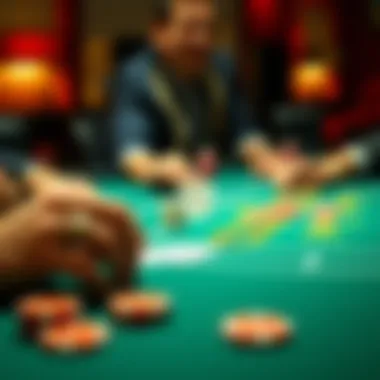
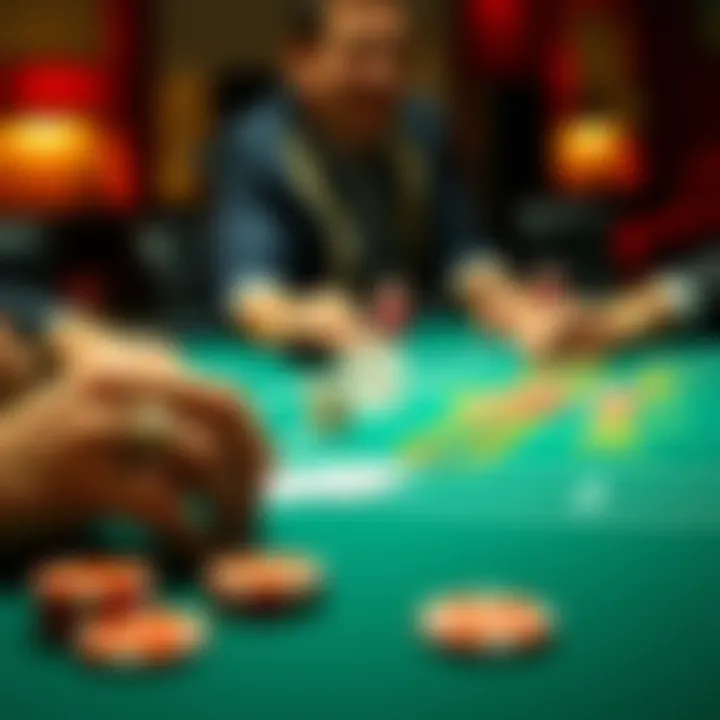
- Increase Your Bets: When the count is positive, raise your bet size. More high cards mean higher chances of winning, so increasing your wager can amplify your returns.
- Modify Basic Strategy Decisions: Having more high cards in play means you're less likely to bust. If the count is in your favor, consider hitting more aggressively than usual or standing when you might typically hit, depending on your total. Conversely, a negative count indicates a need for caution. In this scenario, you might want to stand more often or consider lowering your bets.
"The difference between a winning player and a losing player often rests on their ability to adapt to changing conditions, and that includes the cards on the table."
- Surrender Wisely: As the count shifts, so too should your instinct about whether to surrender. Often, an unfavorable count will lean towards more surrenders, as the odds are decidedly stacked against you.
Common Mistakes to Avoid
Understanding the common pitfalls in blackjack is crucial for any player looking to refine their strategy. The usual suspects in this game often lead to unwise decisions that can significantly affect the outcome. Avoiding these mistakes not only protects your bankroll but also enhances your overall gameplay experience. Here, we will explore two critical areas: misunderstanding game rules and overvaluing poor hands.
Misunderstanding Game Rules
A misunderstanding of the game’s rules can be the source of frustration and, ultimately, significant losses for players. No matter how comfortable you are with general card games, blackjack has its own set of rules that are non-negotiable. For instance, one might think they can hit on any hand without repercussions. In reality, various factors—like the dealer’s up card—also play a role in your decision to hit or stand.
Many players overlook essential rules such as the house edge and the significance of the dealer's actions. It's vital to grasp the basic principles: when to split, when to double down, and the scenarios that call for surrendering. Misinterpretations lead to impulsive decisions, often not backed by sound strategy or probability.
Furthermore, misunderstandings can occur between different variations of the game. For example, rules differ significantly between European and American blackjack, specifically about whether the dealer hits or stands on a soft 17. Keep yourself informed. Reading the game’s rules before playing is an excellent way to set yourself up for success. You might think you can wing it, but knowing the rules can save you from costly mistakes.
Overvaluing Poor Hands
Another common misstep involves misjudging the strength of your playing hand. It’s easy to get carried away, thinking that any hand above a 12 is suitable for aggressive play. However, a hand totaling 13 or 14 may not be worth risking another card, especially when the dealer shows a strong card like a 10.
Players often cling to weak totals, overestimating their chances to improve. The temptation to hit and chase a better total can lead to disastrous outcomes. A poor hand might seem promising when emotions run high—"just one more card and I’ll be set!"—but the reality check hits when you bust.
Setting realistic expectations and understanding that a good player will often choose to hold on to low, stable values against a higher dealer's card is key. Remember:
- Always assess your hand's strength in relation to the dealer’s visible card.
- Consider your position in the game. Is it worth risking your current hand?
- Not every low hand is a bad hand; sometimes, the best move is to play defensively and wait for better opportunities.
"A careful player knows when to fold their hand and when to let go of emotions at the table."
By avoiding these common mistakes—misunderstanding the rules and overvaluing poor hands—you not only level up your game but also improve your overall odds in blackjack. Don’t let a simple misstep cost you. Concentrate on learning the game’s intricacies, and you’ll find your decisions becoming second nature.
Finale and Final Thoughts
The world of blackjack is far more than just a game of chance; it’s a complex interplay of strategy, intuition, and psychology. This article has taken a closer look at the vital decision-making process involved in hitting or staying, revealing how these choices can significantly sway your outcome at the table. Reflecting on the fundamental components, we can pinpoint why mastering these decisions is crucial not only for success but also for enjoyment.
One cannot overstate the importance of understanding the game’s basic strategies and the role of probability. Knowing when to hit or stay should not merely be a matter of gut feeling; it should be rooted in calculated decisions based on the situation presented. By employing the principles laid out in earlier sections, players can gain a clearer insight into how specific scenarios dictate certain actions. Familiarity with the dealer's up card, assessing the strength of one's hand, and adapting to how your own strategies stack up against potential busts are all essential for optimal play.
Furthermore, recognizing common pitfalls, such as misinterpretations of the game rules or inflating the value of weak hands, can save players from unnecessary losses. A deeper understanding of these nuances doesn’t just sharpen a player’s skills; it also enhances their confidence as they navigate through games with a sharpened perspective.
Summarizing Key Points
- Strategic Importance: Understanding hit or stay decisions plays a pivotal role in determining your success in blackjack. It’s not just about luck; it’s about smart, tactical choices.
- The Role of Rules: Having a firm grasp on the game’s rules, including defining when to hit or stay, creates a strong foundation for your blackjack strategy.
- Evaluating Hands: Recognizing the strength of your hand in juxtaposition to the dealer's up card can guide your decisions effectively.
- Avoiding Mistakes: Familiarizing oneself with common errors is vital to improving gameplay and gamble wisely.
Encouraging Thoughtful Play
Engaging in blackjack is undoubtedly exhilarating, but it’s essential to approach the game with a discerning mindset. Rather than rushing into decisions, take a moment to analyze the table. Consider not just your hand but also what the dealer might be holding. The art of blackjack thrives on calculated decisions, which means thoughtful play should be priority number one.
Additionally, seek ways to enhance your overall understanding of the game through various resources. Engaging with online forums or educational platforms can provide insight into advanced strategies and player experiences that could bolster your own method.
In closing, the journey to becoming a skilled blackjack player is a continuous one. It requires patience, thorough understanding, and critical thinking. So, the next time you're at the table, take what you’ve learned here to heart, play smart, and enjoy the journey that blackjack offers.
Remember: Each hand you play is an opportunity to sharpen your strategy and refine your skills.
For further reading and resources, you can check sites like Wikipedia, Britannica, or discussions on Reddit for a community perspective.



